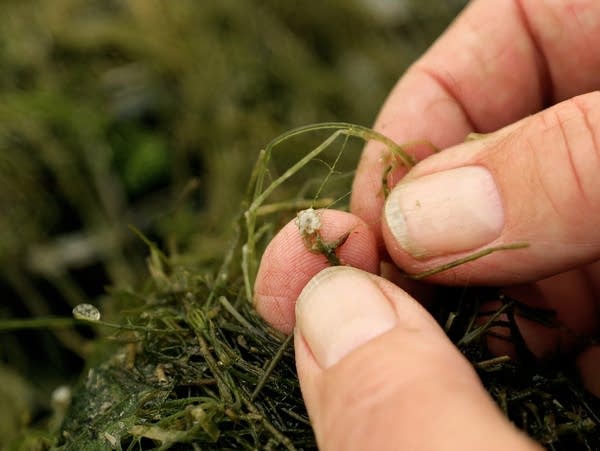In one Minnesota lake, researchers remove invasive 'lake killer' by hand

When starry stonewort is found in a popular recreation lake, it's sometimes considered akin to a death sentence.
Jim Bartelme recalls two years ago when the aquatic invasive species was confirmed in Grand Lake near Rockville, Minn., where he's lived since 1952.
"That was the first headline in the local newspaper: 'Lake killer,' which wasn't a welcome headline," Bartelme said.
But that pronouncement might have been premature. Thanks to an early detection and quick efforts to contain starry stonewort's spread by having divers remove it by hand, the lake's future seems brighter.
Create a More Connected Minnesota
MPR News is your trusted resource for the news you need. With your support, MPR News brings accessible, courageous journalism and authentic conversation to everyone - free of paywalls and barriers. Your gift makes a difference.
Starry stonewort is an invasive algae can form dense mats that choke out native species and make boating and swimming difficult. So far, it's infested 13 Minnesota lakes.

The Grand Lake infestation was caught early, said Dan Larkin, a scientist at the University of Minnesota's Aquatic Invasive Species Research Center. It was first detected during the 2017 Starry Trek, an event where volunteers fan out across Minnesota lakes in search of new infestations of aquatic invasive species.
"It was really a lucky find, because there was very little of it at the time and it was in a pretty isolated area," Larkin said. "The volunteers who got it on their rake brought back this small fragment, and that ended up being enough to identify it."
Working collaboratively, the Grand Lake Improvement District, the Department of Natural Resources and the Aquatic Invasive Species Research Center decided to hand-pull the starry stonewort instead of treating it with an algaecide.
Larkin said hand-pulling wasn't an option in nearby Lake Koronis near Paynesville, where starry stonewort had already spread to about 200 acres when it was discovered in 2015.
"In Grand Lake, it was a really small isolated population," he said. "It made diver hand-pulling practical in Grand Lake, which would not have been the case at Koronis. It's just not feasible on that scale."
For small infestations, targeted hand-pulling of an invasive species can be very effective, Larson said. He said it's labor intensive, and working in the water can be difficult, because sediment gets stirred up from the bottom and creates visibility problems.

"But still, there's nothing to beat that selectivity and effectiveness of just being able to identify your target species, and then remove it by hand," Larkin said.
After two years of pulling, the starry stonewort appears to be contained in Grand Lake, Larkin said. But it's not completely gone, and hand pulling will need to continue, he said. Starry stonewort has never been successfully eradicated from a U.S. lake.
On other infested lakes, mechanical removal and copper herbicide treatments have been used to try to control starry stonewort, with limited success.
Larkin said researchers are learning a lot about the effectiveness of different strategies for controlling aquatic invasive species.
"Can we put a lot of effort into surveillance and early detection?" he said. "Can we find these populations small, at a stage where there is a broader suite of options?"
The lake improvement district and the DNR plan to do monthly surveys of the entire lake to make sure the invasive species hasn't spread, Bartelme said.
In addition, the hours of inspections at Grand Lake's public accesses were increased to make sure the lake isn't infested again and boaters don't transport the starry stonewort to another lake.
Boaters and anglers can help prevent the spread of aquatic invasive species by cleaning all boats and other watercraft, draining water by removing plugs and disposing of unwanted bait in the trash.